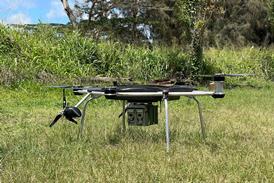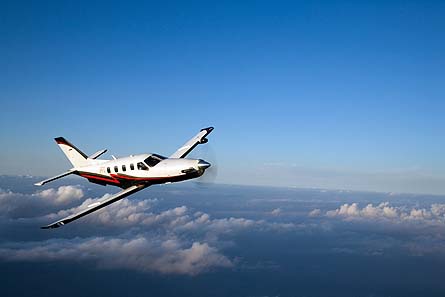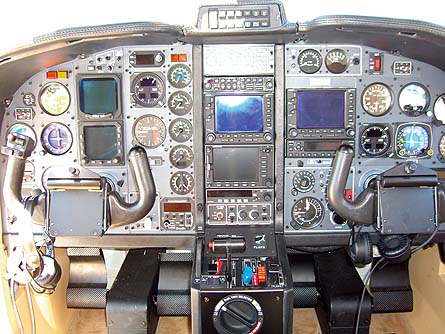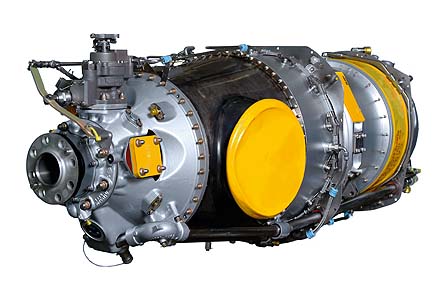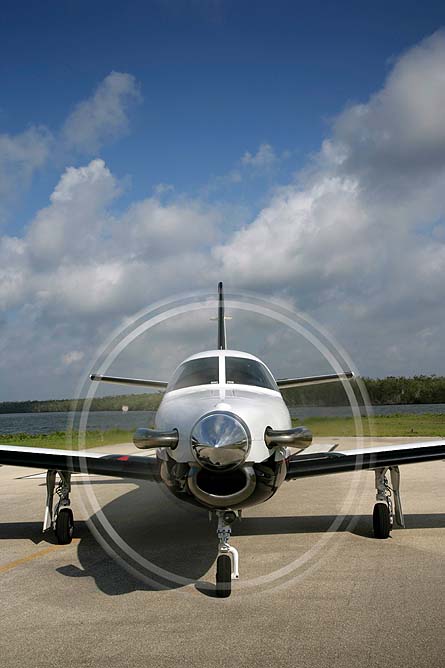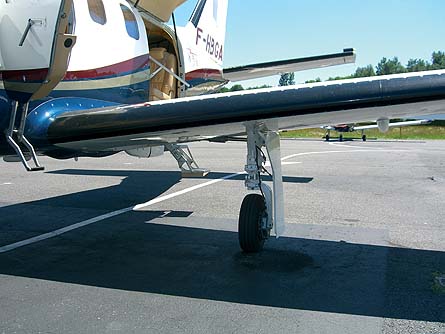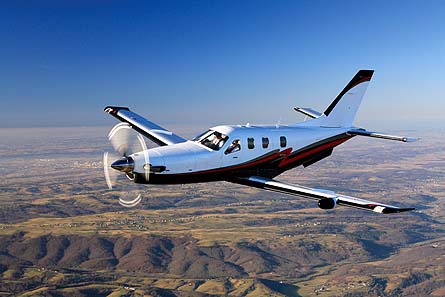By Peter Collins in Tarbes
Europe’s EADS Socata is going head to head with very light jets (VLJ) with its newly certificated TBM850, a six-seat, fully pressurised, high-altitude and high-speed single-engined turboprop.
|
|
|---|
| An uprated engine delivers more power over the whole flight profile |
An upgrade of the TBM700, the TBM850 is powered by an uprated Pratt & Whitney Canada PT6A-66D, which has single-crystal turbine blades enabling higher operating temperatures and, combined with a new compressor first stage, delivering enhanced high-altitude performance. The -66D is flat-rated to 850shp (635kW), giving the TBM850 a maximum cruise of 320kt (590km/h) true (approximately 215kt indicated) at 26,000ft (7,900m). Maximum speed is 266kt indicated.
After take-off and all the way to the start of approach – in other words when flaps are up – the -66D can be run at its 850shp rating by moving the flap selector to a forward, gated position that sets a new torque limit of 121.4%. With the flap lever back into its normal range, the -66D produces 700shp at a pilot-controlled 100% torque, with the over-torque limiter set at 110% and 770shp.
The -66D has a revised engine bleed-air system using a lower-pressure compressor bleed source (P2.5), which is complemented by the standard PT6A higher-pressure bleed source (P3) only at high altitude and long-range cruise (around 250kt) power settings. These features enable the -66D to deliver more power over virtually the whole flight profile and allow the aircraft to maintain “jet-like” speeds and climb rates.
Upgraded avionics give the TBM850 reduced vertical separation minima (RVSM) and basic area-navigation (B-RNAV) compliance; GPS navigation, 8.33MHz radios, emergency locator transmitter, engine trend monitoring and full autopilot; electronic attitude director and horizontal situation indicators (EADI/EHSI); full instrument flight rules and flight into known icing capability; and traffic collision avoidance (TCAS) and enhanced ground proximity warning (EGPWS). As a result, the aircraft complies with the latest regulations and can fly into any international airport after departing a grass strip, or vice versa.
The TBM850 has a maximum cruising level of 31,000ft at a cabin altitude of 10,000ft (0.42bar/6.2lb/in2 pressure differential). By comparison, VLJs can cruise at around 340kt, but only at or close to their maximum cruise level of 41,000ft. The TBM850’s quoted time to climb is 15min to 26,000ft and 20min to 31,000ft, at gross weight. The aircraft is certified for single-pilot operation with up to five passengers.
Socata’s Tarbes facility in south-west France has switched production to the TBM850 after producing more than 320 TBM700s since 1990. The TBM850 first flew in February 2005 and European certification was gained in November, with US approval following in January. The first production aircraft was delivered in late January. A further 36 had been ordered, and 14 delivered, by the time of Flight International’s test flight in early June. Socata is to build about 42 aircraft a year.
The order split is around 70% USA, 20% Europe and 10% rest of the world (especially Australia). The main market is the owner/flyer, corporate operator and fractional ownership. Socata does not expect a European air-taxi market until the European Aviation Safety Agency decides the long-running argument over allowing single-engined turboprops for commercial/public transport use.
The TBM850 retains the same four-blade, fully feathering, constant-speed Hartzell propeller – driving to a maximum of 2,000rpm – and has the same overall dimensions as the TBM700 (see table). Fuel capacity is 1,066 litres (281USgal/860kg) of Jet A1 in two tanks, one per wing and automatically balanced. Airframe limits with flaps up are a generous +3.8g and -1.5g. No g-meter is fitted as standard.
The TBM850 is cleared for take-off and landing at airfield elevations up to 8,000ft. Maximum demonstrated crosswind for take-off and landing is 20kt and the tailwind limit is 10kt. The aircraft is protected by pneumatic de-icing boots on the leading edges of the wing, stabiliser and fin and electrically heated propeller blades, engine intake and forward windscreens.
Propeller advantage
Aircraft operating weights are: typical empty 2,132kg (4,700lb), maximum take-off (MTOW) 3,354kg, maximum landing (MLW) 3,186kg, and maximum payload 605kg, or 385kg with maximum fuel. Maximum baggage capacity is 135kg: 120kg in the pressurised cabin and 15kg in the rear unpressurised compartment.
Quoted take-off distance at MTOW, no wind and ISA to a 50ft obstacle clearance height is 866m and landing distance at MLW from 50ft is 741m. The aircraft is certified to operate from tarmac, grass or semi-prepared surfaces and has a pilot-selectable inlet inertial separator that prevents foreign objects entering the engine when operating on austere fields. In my opinion, this is a major advantage for the propeller over the jet on anything other than a pristine runway surface.
Aircraft structure is primarily aluminium. The gear is hydraulically actuated and electrically signalled. The main-wheel disc brakes are hydraulically operated by toe brakes from either pilot position. Nosewheel steering is always active and directly linked to rudder pedal deflection. Electrics are 24V DC and a ground power unit can be plugged in to provide power and cooling without starting the engine.
Manual controls
Aircraft controls are dual, conventional and unpowered: cable to the rudder and ailerons and rod linkage to the elevators. Electric trim is provided on the aileron and rudder; both manual and electric trim on the elevator. Roll control is enhanced by spoilers directly linked to each up-going aileron. The wide-span slotted flaps have three positions (up/0°, take-off/10° and landing/35°), are electrically operated with asymmetry protection, and give the aircraft a final approach speed of 80-85kt.
|
|
|---|
| The cockpit has a hybrid analogue/digital feel |
The propeller features a pilot-selectable full reverse position gated through the throttle lever, negating the need for any lift dump, auto-sensed ground spoilers or thrust reversers that VLJs may have to use to meet their stopping distances, especially on contaminated surfaces. This easily controlled and effective braking, inherent in a propeller design, seems to me another essential, but overlooked, factor in the VLJ versus turboprop argument.
Typical equipped price is $2.8 million for the TBM850 with a full options package that includes the RVSM, enhanced avionics, weather radar (mounted in a bullet fairing on the leading edge of the left wing) and luxury interior. This is competitive with a Citation Mustang, but more than an Eclipse 500. Warranty is seven years on the airframe, five on the avionics and engine and two on the propeller.
Direct operating cost (DOC) is quoted at €310/h ($388/h), including fuel/oil and the total spares/maintenance cost under a complete-aircraft “power by the hour” maintenance scheme. Insurance is expected to be cheaper than for a VLJ, certainly initially, and crew costs should be equal. Socata claims the TBM850’s DOC is 50% lower than for a VLJ. Engine time between overhauls is 3,500h and the airframe requires a major inspection after 10 years
To counter the argument that, if it is speed you are paying for, a VLJ must win hands-down, Socata makes two typical sector comparisons: one over 920km (500nm) and one over 2,220km, both carrying one pilot, three passengers, luggage and NBAA IFR reserves. In the first scenario the TBM850 cruises at FL260 and its maximum of 320kt true airspeed, while the VLJ cruises at FL350 and 340kt/Mach 0.59. The TBM850 will climb to its cruise altitude quicker and hold its cruise speed longer, says Socata, its maths showing the VLJ beating the TBM850 by just 7min over a total sector time of 1h 45min.
|
© Peter Collins |
|---|
| Power comes from un uprated Pratt & Whitney Canada PT6A-66D |
In the second scenario, the TBM850 cruises at FL310 and its maximum of 315kt true airspeed, while the VLJ is at FL410 and its long-range cruise of 300kt/M0.52 to prevent it having to make an intermediate fuel stop. This time, Socata argues, the result is reversed and the TBM850 beats the VLJ by 11min over a sector time of about 4h. In both scenarios the VLJ, while flying faster at its final cruise altitude, may conflict with commercial traffic cruising at M0.75-M0.85 at the same level, Socata argues, and so often be blocked by ATC from flying above FL310.
With maximum fuel, the TBM850 has a quoted range of 2,810km at long-range cruise and 2,525km at maximum cruise. At maximum payload and cruise speed, the quoted range is 1,860km. Outright speed is an advantage for a VLJ, but the TBM850 has the fuel capacity to make its increased cruise speed count over longer ranges.
The flight test was conducted from Tarbes using TBM850 demonstrator F-HBGA. Aircraft weight was 2,145kg empty and 2,945kg all-up with two crew and 700 litres of fuel, but no passengers, cargo or ballast. My safety pilot was Alain Jaubert, a demonstrator pilot, training instructor and production test pilot with Socata. After a 45min introduction, we went to fly. I had no time for ground school, cockpit familiarisation or simulator time and I had never flown a single-engined, high-performance turboprop of this type before.
I wanted to put myself in the role of an owner/operator with low flight-hours experience who wished to use the TBM850 for business, but still land at either an international airport or a private airstrip. I wanted to see not only how sophisticated and easy to use the avionics were, but also how forgiving the handling qualities were in case I made an elementary mistake as that low-time pilot.
Entry and exit can be through the large, upward-hinged cabin door on the left-hand side, fitted with fold-out steps, but this is best used by the four passengers using the paired facing seats. This aircraft was fitted with the optional pilot’s door on the left-hand side, just forward of the wing leading edge, again with fold-out steps. This is ideal for the pilot. Cockpit storage space is not enormous, but the right-hand front seat could be used during single-pilot operation.
The seat features a four-point harness, is fully adjustable in height, reach and rake and was comfortable. Rudder pedals were easily adjustable. There is no design eye-point reference, but the long nose made it obvious where to set the seat height. Field of view was fine forward, down through the front quarter, across the wingtip and towards the tail, but I had to duck my head slightly when looking left and level because of the extra pillar thickness introduced by the pilot’s door.
The cockpit had a hybrid analogue/digital feel to it initially, but with dual independent Garmin GPS navigators, dual transponders, EADI and EHSI and a Honeywell map/EGPWS/TCAS/weather radar display, the avionics offer outstanding guidance potential. I liked the neat central, head-up autopilot flight guidance panel (FGP) and the well laid-out overhead cockpit panel. The complete aircraft, inside and out, was beautifully finished.
|
|
|---|
| The TBM850 has the fuel capacity to make its increased cruise speed count over longer ranges |
The cockpit reminded me of a cross between a luxury car and a modern airliner. The central console features a throttle lever (black), propeller lever (blue) and condition lever (red, but essentially just a fuel cock). Despite the 33,000 examples of the PT6 in operation worldwide, I find it incredible that P&WC has not produced a version with full-authority digital engine control (FADEC) that would provide true “single-lever” operation, an automatic thrust rating system and allow engine parameters to be displayed digitally on an integrated screen.
I sat in the left-hand seat to fly the complete sortie. Engine start was simple with the starter engaged on the overhead panel and condition lever moved to the low idle position as NG (high-pressure core rpm) passed 10%. As NG passed 50%, the starter was manually disengaged, booster pump and fuel set to auto and condition lever set to full. The complete start sequence to idle took about 25s, peak turbine gas temperature was 685°C (1,265°F) against a start limit of 1,000°C. With simple post-start checks complete we were ready to taxi within 90s.
Ground handling
Ground handling was a delight. Nosewheel steering was accurate without being overly sensitive, brakes were firm and progressive and the throttle could be pulled back into the reverse range to keep taxi speed under control almost without using wheel brakes. The interior was quiet, with no vibration. The TBM had the nimble feel of a smaller aircraft when on a tight and restricted ground apron.
Flaps were set to take-off, pitch trim was set at 12%, rudder trim at the offset-right green mark (to compensate for take-off torque) and aileron trim neutral. There is no configuration warning system, so these trims had to be set as part of the checklist. The trim panel is mounted horizontally behind the throttle, propeller and condition levers so the trim gauges were obscured with the throttle lever forward. I recommend relocating the panel and aileron trim switch, which seemed exposed and easy to operate inadvertently on the forward face of the throttle lever console (elevator and rudder electric trim switches are mounted on the stick top).
Take-off was from runway 20, wind 4kt from 90°, QNH 1026mbar, outside air temperature +13°C and cloud and visibility okay. After lining up with the runway, power was increased to bring the propeller up to 1,900rpm, the overspeed governor checked (taking about 3-4s), toe brakes released and power increased to 100% torque with the propeller now governed automatically at 2,000rpm. Flying mostly jets, I had forgotten just how quickly turboprops deliver their power; the initial acceleration was brisk and I had to be careful not to exceed 100% torque. I also had to learn to use my feet again, because about 5kg of right rudder pedal force was needed to counter a slight swing to the left. But this was easily contained and the aircraft drifted no more than 1-2m from the centreline. As we accelerated, the rudder became more effective, and the pedals could be centralised by the rotate point at 90kt. I estimate the take-off roll was 450m and close to published figures.
Rotate pitch forces and displacements were small, the aircraft lifted cleanly, and I selected a 10° climb attitude easily and accurately. Once in a positive climb, the gear was raised without any noticeable trim change. Flaps were raised at 110kt and the aircraft accelerated naturally towards 150kt, although 130kt is quoted as the best initial climb speed. Trim changes with flap were small and out-of-trim stick forces generated by speed change were positive and could be countered by a “blip” on the electric trim every 5-10s. ATC cleared us to FL280 (28,000ft/8,500m) into the test area, where conditions were perfect with no clouds, clear horizon and no turbulence.
Flaps raised, I took the flap selector through the gate and into the “850” position where I could set torque to 121.4% and use the full 850shp of the -66D. The lack of a FADEC meant power limits had to be checked at regular intervals in the climb, and torque or NG set as appropriate to the most limiting parameter. I noted that, after the “850” position had been selected, there was no amber light or status caption to remind the pilot what power mode was in effect.
The climb allowed me to check the mechanical control characteristics when hand flying. Breakout force was small at about 0.5kg, freeplay in pitch and roll axes also small at 1-2mm, centring absolute and no oscillations apparent after sharp inputs. Trimmability was good in all axes.
FL280 was achieved in 15min even after some intermediate level-offs from ATC. Full power at FL280 gave a torque setting of 109%, NG of 102%, 800°C inter-turbine temperature and 200kt indicated airspeed. The electronic engine trend-monitoring panel showed us at 315kt true airspeed/M0.517 with a fuel flow of 230 litres/h. Long-range cruise gave around 250kt and 160 litres/h. Again the figures looked close to those published by Socata.
I then dived close to the maximum speed (VNO) of 266kt indicated and a descent rate around 7,000ft/min (35.6m/s), which could be used in the event of a decompression. Controllability at VNO remained good in all axes, forces did not increase significantly, there was no control “buzz” and no discernible increase in noise or vibration in the cabin. I had no need to change propeller RPM throughout the dive, or indeed the entire flight, so the engine could be treated as a single-lever operation using just the throttle. My only moan was the non-cancellable warning horn when the throttle lever was moved back below about 7% torque. I recommend a horn cancel button, perhaps linked to the radar altimeter.
I levelled at 15,000ft for a quick stability and stalling assessment. Speed was increased from 140kt to 180kt and back again. Longitudinally, stick forces were positive, about 7kg held in pitch against the 40kt of out-of-trim speed, giving the pilot good feedback on changes away from trimmed speed. Additionally, after trimming, the stick displacement was almost unchanged from the initial neutral trim position, which I liked since the yoke would not end up too far forward or aft at high or low speed. Trim changes with power were negligible, small with flap movement up or down, but with gear selection came just a hint of some fish-tailing as the main legs lowered slightly asymmetrically and the undercarriage doors acted as small outboard fins. This disappeared when the gear was locked down.
Short-period (manoeuvre) reaction was rapid at about 1s. Long-period (phugoid) reaction was around 30s and it should not be a problem for a pilot cruising at altitude to hold an accurate flight level when flying manually. A couple of wind-up turns at 180kt were made up to an estimated +3g with no sign of wing rock or buffet and all pitch control gradients were linear in terms of force and displacement.
The lateral and direction assessment at 140-160kt showed that the aircraft rolled in the direction of applied rudder, that adverse yaw at the start of any turn was small and quickly washed out by the fin and that up to 10° of sideslip could be generated at full rudder-pedal deflection and held with about 10° of opposite bank – providing good “kick-off drift” capability in a crosswind landing. Spiral stability was neutral and Dutch roll was damped over two to three cycles. Roll performance was impressive with rapid onset, a time to roll through 90° of about 2.5s and with a sustained roll rate of around 60°/s. Overall, the control harmonisation, power and forces were as nice as in any aircraft with manual controls I have flown.
I progressed to wings-level unaccelerated stalls at all three flap positions and an “approach type” accelerated stall at 120kt. The unaccelerated stalls showed a docile aircraft with a clear audio warning (a stall vane is mounted on the right-hand wing) some 5-10kt above stall speed. The actual stall was characterised by unmistakable pitch nodding, buffet and a rate of descent of around 2,000ft/min. Roll control remained effective in the stall and there was no hint of uncontrollable wing drop.
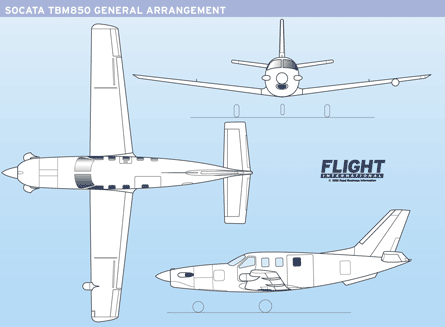 |
|---|
Stall speeds were 75kt clean, 70kt with take-off flap and 60kt with landing flap. Recovery was instantaneous with a small release of back-pressure and application of power. Height loss would be small (around 200ft) even if the pilot only recognised the stall itself having ignored the audio warning. An accelerated stall with mid-power (40% torque) and take-off flap was assessed by turning hard at 120kt slowing to 100kt and increasing bank to 70-80°. Only then could I induce some abrupt wing-drop, but this is an extreme approach manoeuvre obvious to any pilot.
Jaubert helped me set a track on the Garmin GPS back to Tarbes for a high-speed ILS approach to runway 20. I coupled the autopilot to NAV, used speed mode at 210kt and descended with about 10% torque towards the start of the ILS at 3,000ft, 28km from our present position. The Garmin was easy to use and interpret and functioned as a combined flight-management system and radio-management unit. The autopilot was easy to couple to lateral or vertical navigation modes and the mode annunciations on the EADI were clear and easy to interpret. But I felt the altitude select/vertical speed modes on the separate vertical mode panel, separate from the FGP, were awkward to set and the values displayed could be misinterpreted.
Speedy arrival
I comfortably made our start point for the ILS, moved the flap selector from 850 back to zero (reducing the torque limit to 100%), set full power and let the airspeed stabilise at 210kt at 3,000ft. The ILS was then flown autopilot-coupled at 210km until 3nm and 900ft AGL. Power was reduced to about 7% torque; gear and take-off flap selected at 178kt; landing flap selected at 122kt; 30% torque set as airspeed passed 90kt; and the aircraft settled, configured and stable, at 80kt and 300ft AGL (100ft above decision height). It was an impressively fast and smooth yet simple-to-manage arrival. Power was held until just above touchdown in the final flare and then reduced to idle, which allowed the aircraft to sit positively and cleanly on to the runway.
The roller was easy to fly with flap reset to take-off, but I had to remember to be sensitive with power application to prevent torque swinging beyond 100%, and to use my feet to compensate for yaw against torque. But these were small points in learning turboprop technique after flying jets and were corrected by my next touch-and-go. I followed this with a visual circuit (1,000ft AGL downwind at 120kt); a flapless circuit (100kt final approach); a glide circuit simulating engine-out (initial glide at 110kt clean, 105kt intermediate glide with gear down and take-off flap); and a low-level circuit (at 500ft AGL downwind). All were a delight to fly and position easily and accurately from the downwind position to touchdown.
|
|
|---|
| Fold down steps make entry easier |
The final full stop came from the low-level circuit. I touched down at about 75kt, immediately lowered the nose and selected full reverse-pitch by moving the throttle lever into the reverse gate. Deceleration was positive and rapid without being uncomfortable. I cancelled reverse pitch and used wheel brakes from about 40kt. Total ground stopping-distance was no more than 350m. We had been airborne for 1h 15min and had used just 322 litres of fuel.
The TBM850 has a “looks right, feels right” quality that was obvious to me from strap-in until shut-down. It was easy to fly as a single pilot, had single power-lever operation from take-off to touchdown, was easy to land and to stop and, for a low-time pilot, would require minimum currency to stay proficient. It handled much like a jet, had the flexibility to land just about anywhere and on just about anything, had bags of excess power available within a heartbeat and seemed to offer a great mix of performance, potential, safety and sophistication.
Whilst in absolute terms the TBM850 may not fly as fast or cruise as high as a VLJ, in my opinion it was 95% there at all times. In terms of real-world performance – the time to get somewhere in real ATC conditions – there would be little difference between the TBM and a VLJ. The major difference to an operator would be in the cost of ownership especially in terms of fuel, Socata claiming a 50% lower fuel consumption than a VLJ.
|
|
|---|
| Wing mounted weather radar is an option |
Source: Flight International




